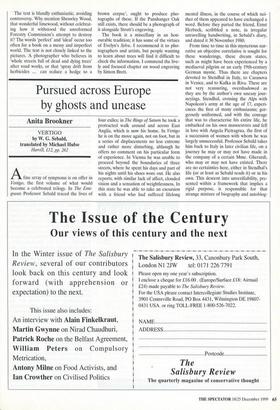Exploring branch lines
Oliver Rackham
SILVA: THE TREE IN BRITAIN by Archie Miles Ebury Press, .f30, pp. 400 Go into a picture gallery, choose a landscape painting at random, and ask yourself, 'What is that tree?' Surprisingly seldom can you give a definite answer. To
A mature Scots pine in Glen Affric depict a convincing tree is a difficult accomplishment, which few artists attained. The little-known Simon Benninck and Thomas Hearne were good at it; Claude Lorrain and Gainsborough were not; Constable and Samuel Palmer could man- age it on a good day. Even pictures painted specially for identification often fail to dis- tinguish, say, beech from lime; a tree- recognition poster was popular for many years before anyone noticed that most of the trees on it were not recognisable for the kind they were labelled.
No picture of a big tree can be naturalis- tic: it would be far too complex. All pic- tures of trees are caricatures, and the artist has to identify the characteristic features to be retained in the picture. Most artists throw away the distinctive features and keep the non-distinctive ones, the result having something of the anonymity of a bad portrait.
Tree artists do odd things. I puzzled over Gainsborough's so-called 'Cornard Wood': why is it so unlike the real woods of 18th- century Great and Little Cornard? Then Susan Foister demonstrated that it was a reworking of a Dutch landscape by Ruis- dael, having little more to do with Cornard than Piranesi's 'Caned d'Invenzione' has with real Italian gaols.
Archie Miles is a photographic tree artist: he knows and loves wild trees, and records their spirit with enthusiasm. His is a book of magnificent photographic works of art (even if the colours are often exag- gerated, as is fashionable). Some are startling, like the redwood which fell over long ago and went on growing as if nothing had happened. He celebrates great coppice stools, ancient pollards, gnarled mountain oaks, trees sprouting from rock: one would wish for more of these wonderful trees and on a larger scale.
The caricature problem arises here too. Not even the camera delineates all the complexity of a big tree; the photogra- pher's skill lies in selecting and shooting the distinctive features. It is a pity that Mr Miles often shows a big, youngish, leafy tree silhouetted against the sky, a presenta- tion which makes most trees look much the same. The dead boughs which give old trees their character are banished from these pages almost as thoroughly as Gains- borough omitted the dead boughs on Ruis- dael's beeches. Another drawback is the absence of scale objects. Appreciation of fine trees depends on size, and without something to compare — a venerable col- league, a pretty girl, a dog, a bicycle — they lose half their point.
As in all coffee-table books, the text fills exactly the spaces between pictures. It sets out what people, from the ancient Greeks onwards, have written about trees: their uses, literary, religious, medicinal, and artistic associations, and a little on their personalities and behaviour. It is a fascinat- ing mass of statement, which could have done with editing. Fact and fiction cannot easily be distinguished, since the author seldom attributes or verifies his remarks. Half an hour with the Oxford English Dic- tionary would have disproved most of his `derivations' of names of trees. Someone who repeats the notion that the service tree is called after Latin cerevisia, 'beer' (rather than being just the Indo-European word for the tree) should at least give a recipe for service beer and tell us what it tastes like. Someone who recycles (yet again!) the notion that ancient yews in churchyards derive from heathen shrines predating the church should cite documents or excava- tions showing that pre-Christian religions did indeed venerate yew-trees. The text is blandly enthusiastic, avoiding controversy. Why mention Shrawley Wood, that wonderful limewood, without celebrat- ing how it withstood the unreformed Forestry Commission's attempt to destroy it? The words 'perfect' and 'ideal' occur too often for a book on a messy and imperfect world. The text is not closely linked to the pictures. A photographer who believes in 'whole streets full of dead and dying trees' after road works, or that 'spray drift from herbicides ... can reduce a hedge to a brown corpse', ought to produce pho- tographs of these. If the Panshanger Oak still exists, there should be a photograph of it alongside Strutt's engraving.
The book is a miscellany in an hon- ourable tradition; it has some of the virtues of Evelyn's Sylva. I recommend it to pho- tographers and artists, but people wanting to learn about trees will find it difficult to check the information. I commend the live- ly and focused chapter on wood engraving by Simon Brett.























































































































 Previous page
Previous page